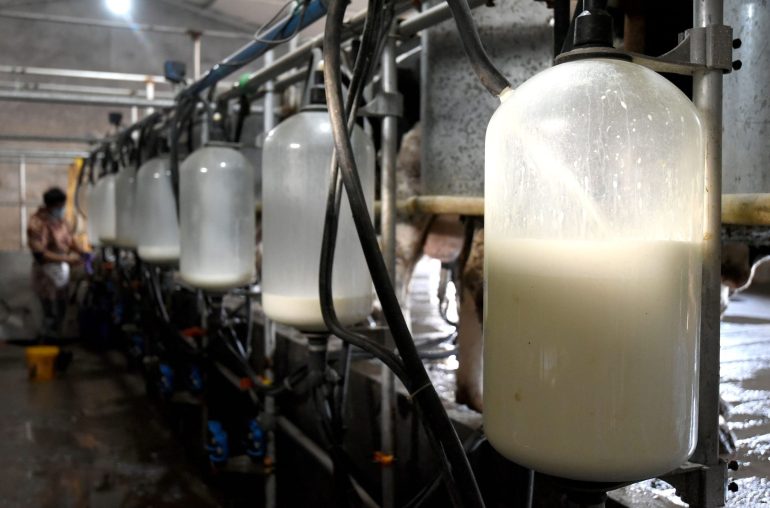It’s hard to imagine living without milk, from the perfect bowl of cereal to a milky cup of tea. Around 700 billion litres of cow’s milk is produced every year and the British dairy industry is responsible for around 15 billion litres.
Today, milk is one of the most popular beverages in the world. It is a major source of nutrition for people of all ages and plays an important role in many cuisines. In fact, it’s believed over six billion people drink milk regularly, so let’s find out how milk is produced.
A Short History of Milk

Barista pouring steamed milk to hot coffee to making latte art (Photo: Boy_Anupong via Getty Images)
The history of milk is a long and interesting one. Milk has been a part of the human diet for thousands of years, and has played an important role in many cultures.
The first evidence of milk production comes from between 9,000 and 7,000 BC in ancient Mesopotamia. This early form of milk was most likely obtained from sheep or goats. By 4,000 BC, milk was being produced on a larger scale in many parts of the world, including Europe, India, and China.
When the Industrial Revolution arrived, new manufacturing processes and faster transportation meant that milk could be transported around the country and consumed by more people. As the age of refrigeration and pasteurisation arrived, it could be stored for longer and it became a daily staple. Here is how milk is manufactured.
How Milk is Produced

Example of milking equipment (Photo: Future Publishing via Getty Images)
Milk is around 90% water. The remaining components are mainly fats, proteins and sugars. This explains why it is such a hydrating drink.
Milking Cows
Whilst milking used to be done by hand, it’s now done using vacuum machines that take milk twice per day. Cows are milked using a machine that attaches to their udders and extracts the milk. The machine is connected to a large tank where the milk is stored. As the raw milk is taken through pipes into large tanks, it’s refrigerated at four degrees Celsius. The milking process usually takes around 10 minutes per cow and is the start of the process of how milk is made.
Separating
The milk separating process is a key step in the production of dairy products. In this process, milk is separated into its component parts: cream, skim milk, and whole milk. This separation is accomplished by centrifugal force, which is created by spinning the milk at high speeds. The milk is passed through an apparatus called a clarifier, which removes any debris in the liquid. Then it’s passed through a separator, which collects the cream away from the skimmed milk, controlling the fat content of the final product. Any extra milk fat can be used for cream and butter.
Pasteurising
To kill off any remaining bacteria, the milk is pumped through a pipe at 72 degrees Celsius for 15 seconds. A sensor at the end of the pipe detects the temperature of the milk just in case it needs to be reprocessed. This is one of the most important parts of the modern process of how milk is manufactured.
Homogenising
At high pressures and by passing it through small holes, the size of the milk fat particles is controlled and the mixture is evenly distributed. At this stage, the milk can be cooled down to four degrees Celsius.
Fortifying
Fortifying milk is the process of adding nutrients to milk to improve its nutritional value. Fortification is often used to increase the levels of vitamins and minerals in milk that are important for human health, such as vitamin A, vitamin D, and calcium. It can also help to improve the shelf life of milk and make it more resistant to spoilage. There are several methods of fortifying milk, but the most common method is to add powdered vitamins and minerals to milk that has been pasteurised and homogenised. Fortifying milk in this way is a simple and effective way to improve the nutritional value of milk without changing its taste or texture.
Packaging
The milk can finally be pumped into cartons of varying size, while sell by dates will be added to ensure retailers only sell it for as long as it can be safely stored. It can then be shipped out to retailers. This is the final step in the modern process of milk production.











